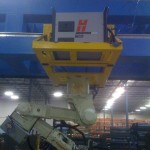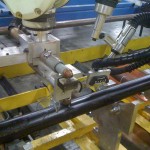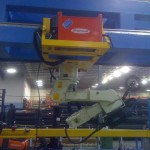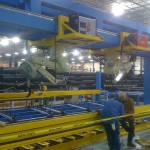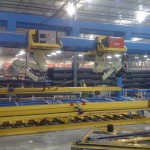At that point in time a human was being used to load a roto-welder for the purpose of producing the product.
The employee loaded the pipe and then had the roto-welder plasma cut the saddle joint for the nipple to be welded on. Once the saddle joint was cut then the employee loaded the part with a nipple and clamped it in place. Once this was done then the employee would have the roto-welder weld the nipple to the pipe. This process was repeated as necessary on each pipe and then manually unloaded. Negatives of this type of production is manpower, but also the quality of the welds.
The roto-welder holds the welding torch in a fixed plane while rotating 360 degrees around the saddle joint weld. There is where the problem occurs. There is no ability to articulate the torch in many positions required while rotating around the part resulting in bad welds (over 20%).
The Vector Automation solution uses two robots, one for welding and the other robot for plasma cutting, probe, and nipple placement.
The Vector Automation solution is completely automated from start to finish. A pipe is introduced to the system already cut to length and has a bar code placed on it. The bar code contains all the information required for the production of the particular pipe (i.e.: diameter, wall thickness, length, nipples required, location of nipples, and rotation of nipples.
Production flow is as follows:
- A pipe is introduced into the system and the bar code read
- The pipe is indexed into position and the manipulator picks the pipe off the index chain and introduced it to the system for processing
- The plasma robot gets the required nipple and then proceeds to probe the pipe to see if it is bent. If it is bent then the robot will make allowances in the program so as to weld the nipple in the correct position as well as cut the saddle joint correctly also.
- The plasma robot cuts the saddle joint and then places the nipple into position to be welded.
- The welding robot comes over and tack welds the nipple in 3 places so the plasma cutting robot can leave and perform the same actions on another place along the pipe while the welding robot is finish welding the tacked on nipple.
- This process is repeated until the correct number of nipples is welded on the pipe before leaving the weld process cell.
- Once the pipe is completed then it is expelled from the cell and the process is repeated. Production gains have been 500% with leakers eliminated.

